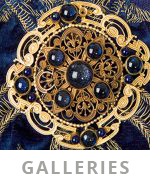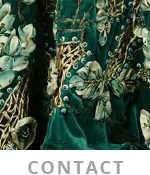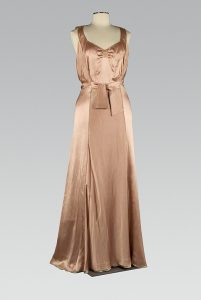Apr 22, 2017
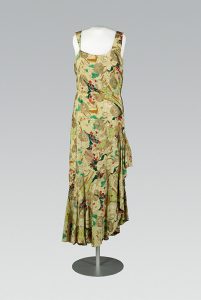
This asymmetrical evening dress is constructed from silk crepe de chine, printed with a floral motif and flowers embroidered in metallic thread.
In early 20th century, Thurn was a very exclusive dress shop that carried Paris imports as well as selling their own versions of custom made garments under the Thurn New York/Paris label.
Apr 16, 2017
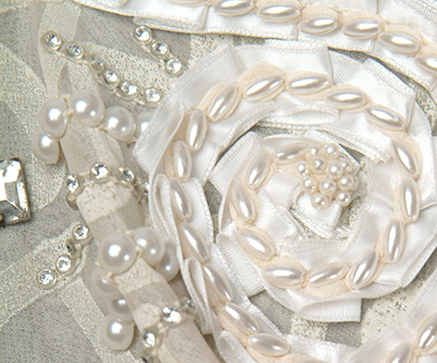
This evening dress by British fashion designer Zhandra Rhodes, c.1970, was imaged and archived as part of the Drexel Digital Museum project. The evening dress is included in the holdings of the Fox Historic Costume Collection, Drexel University. It is constructed from silk georgette, silk screened with one of Rhodes signature prints. It is embellished with ribbon applique, rhinestones, pearls and seed pearl beading.
Between 1966-69, Rhodes and a fellow student, Sylvia Ayton, opened a boutique together called the Fulham Road Clothes Shop. Ayton designed the clothing and Rhodes supplied the textile designs from which they were made. She produced her first collection showing loose, romantic garments. In 1969, Rhodes and Ayton went their separate ways, with Rhodes establishing her own retail outlet in the fashionable Fulham Road. Rhodes was one of the new wave of British designers who put London at the forefront of the international fashion scene in the 1970s. Her designs are considered clear, creative statements, dramatic but graceful, bold but feminine. Rhodes’ inspiration has been from organic material and nature. Her unconventional and colourful prints were often inspired by travel; chevron stripes from the Ukraine and the symbols of the North American Indian, Japanese flowers, calligraphy and shells.He r approach to the construction of garments can be seen in her use of reversed exposed seams and in her use of jewelled safety pins and tears during the punk era. She made her biggest splash in 1977 with the establishment take on punk which she called Conceptual Chic. She used kilts and safety pins – pre Versace – to form a sort of embroidery, mixed with loosely drawn figures screen-printed on silk jersey, or on the newly developed Ultrasuede fabric.
Rhodes is the founder of the Fashion and Textile Museum in London, which was opened in May 2003 by Princess Michael of Kent. In November 2009, Rhodes was appointed Chancellor of the University for the Creative Arts, one of the UK’s newest universities, and only the second to focus specifically on art and design. On 26 March 2013, Rhodes launched a Digital Study Collection of 500 of her iconic garments from her private archive, as well as drawings and behind-the-scenes interviews and tutorials in her studio.The Zandra Rhodes Digital Study Collection was developed through a project led by the University for the Creative Arts and funded by Jisc. https://www.zandrarhodes.ucreative.ac.uk
Apr 16, 2017
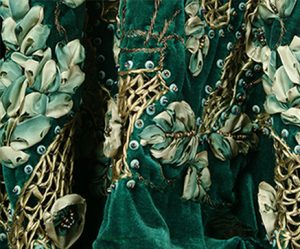
Sadie Nemsor, an American fashion designer, sold her highly sought-after gowns in upscale New York City departments stores. She was a front runner in cubist dress design. This evening dress, c. 1923, is of green silk velvet. It is embellished with beading, and ribbon and soutache applique, above the hem and for the belt. There is a bow on the shoulder. A separate green velvet sash, worn around neckline, completes the ensemble.
Nemor’s business was family owned and family members all specialized in different areas of design work. Ms. Nemserand her husband were premier delegates of the “Congress of Garment Retailers of America”. In 1928, he was awarded the “French National Legion of Honor” for his and Sadie’s endeavors for concordance between French and American garment industries.
Apr 16, 2017

This evening gown is a column of silk net embellished with plastic bugle beads and paillettes in a tartan plaid pattern.
In October, 2016, Mr. Galanos donated his personal archive of 800 pieces of his fashion design and ephemeral to the Fox Historic Costume Collection, Drexel University.
James Galanos was born September 20, 1924 in Philadelphia, Pennsylvania, the only son of Greek-born parents. Galanos graduated from Bridgeton High School in Bridgeton, New Jersey in 1942 and went to New York City to enroll at the Traphagen School of Fashion. After eight months, in 1943, Galanos left the school because he felt that what he wanted to learn could only be acquired from practical experience in the garment industry.In 1944, Galanos got a position as a general assistant at the New York East 49th Street emporium of Hattie Carnegie, the incubator of such talents as Jean Louis, Pauline Trigère, and Norman Norell and began selling his sketches to individual manufacturers on Seventh Avenue for less than $10.00 per sketch. Originally hired to to launch a ready-to-wear dress business in California, he was hired by Jean Louis, head costume designer at Columbia Pictures, as a part-time assistant sketch artist. Soon afterwards, textile magnate Lawrence Lesavoy agreed to send the 24-year-old Galanos to Paris, just as couture houses there were rebounding from the war. Couturier Robert Piguet absorbed the American into his stable of assistants, among whom were Pierre Balmain, Hubert de Givenchy, and Marc Bohan.
In 1951, James Galanos decided to take another shot at California, and when the opportunity arose for him to open his own company, Galanos Originals, in 1952, he created a small collection, which was immediately ordered by Saks Fifth Avenue in Beverly Hills. He then opened his New York showroom where a Neiman Marcus clothing buyer discovered him and predicted his styles would soon “set the world on fire.” Stanley Marcus, the president of Neiman Marcus, agreed and soon proclaimed that the greatest and most treasured luxury in the world for a woman to have would be a dress by James Galanos. From this first collection, his clothing has been admired for its particularly high quality, especially considering it was ready-to-wear, not custom-made. In 1953, Galanos embarked on another venture altogether – he began designing for movies. His first job was to create costumes for Rosalind Russell, the star of the forthcoming film “Never Wave at a WAC.” Russell, who at that time was considered the best-dressed of all American actresses, loved Galanos’ designs, and she became his friend and a loyal client. Galanos went on to design costumes for other Russell’s movies.
Galanos gathered some of the most talented craftsmen available in his workrooms; many were trained in Europe or in the costume studios of Hollywood, for whom he continued to design from time to time. His business was more comparable to a couture house than a ready-to-wear manufacturer; there was a great amount of hand work in each garment, and all of his famous beadwork and embroidery was done by his staff. It was precisely this couture quality and the timelessness of Galanos’ designs that caused his clients to never part with their gowns and continue wearing them over many years. But it was also the price tag. “Nobody could afford to dress completely with Jimmy,” Nancy Reagan once confessed. “I hang on to what I have.”
Galanos was named to the International Best Dressed List Hall of Fame in 1982. He won a host of awards during his career, including the Coty Fashion Award in both 1954 and 1956. He was inducted into the Coty Hall of Fame in 1959. Galanos retired in 1998, closing his doors rather than selling the company. He told this author he did not want his legacy reinterpreted by a large house or manufacturer. Galanos died on October 30, 2016 at the age of 92.





